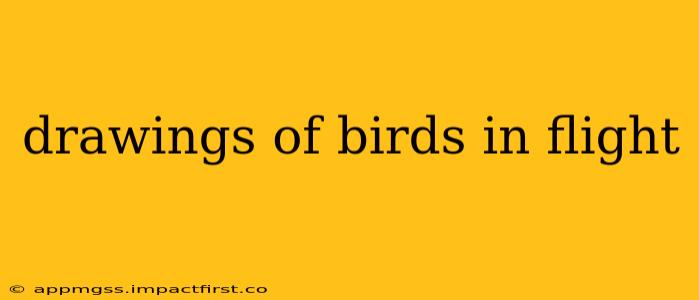Birds in flight – a timeless source of inspiration for artists and nature lovers alike. The graceful curves, powerful wingbeats, and sheer freedom of these creatures have captivated imaginations for centuries. This guide will delve into the art of drawing birds in flight, exploring techniques, tips, and considerations to help you capture their dynamic beauty on paper.
What Makes Drawing Birds in Flight Challenging?
Before we dive into techniques, let's address the elephant in the room: drawing birds in flight is challenging! Their movement is fluid and rapid, making it difficult to capture accurate proportions and postures. The constant shifting of wings and body position requires keen observation and a quick hand. However, with practice and the right approach, you can master this rewarding art form.
How to Start Drawing Birds in Flight: Step-by-Step Guide
1. Observation is Key:
Begin by observing real birds in flight, either in person or through high-quality photographs and videos. Pay close attention to the bird's shape, the movement of its wings, and how its body position changes. Note the subtle shifts in weight and balance as the bird maneuvers through the air. Consider the species; a hummingbird's flight is vastly different from that of an eagle.
2. Simplify the Form:
Don't get bogged down in minute details initially. Begin by sketching the bird's overall shape, focusing on its streamlined form. Think of it as a teardrop or a curved arrow, with the wings extending from the sides. This simplified approach helps establish the basic composition and movement before tackling finer details.
3. Capture the Motion:
Focus on capturing the feeling of movement. Use dynamic lines to suggest the bird's trajectory and the force of its wings. Don't be afraid to experiment with different line weights and styles to convey speed and energy.
4. Understanding Wing Shape and Movement:
Different bird species have different wing shapes and flight patterns. Studying the specific wing structure of the bird you're drawing will dramatically improve the accuracy of your depiction. Observe how the wings change shape during the upstroke and downstroke, and how the tail feathers help with steering.
5. Adding Details:
Once you've established the basic form and movement, you can start adding details. This might include feather textures, beak shape, eye placement, and leg positioning (if visible). However, remember that less is often more, especially when capturing the fleeting moment of flight. Too much detail can distract from the overall dynamism of the drawing.
What Materials Should I Use?
While you can use various materials, a combination of pencils (for sketching and shading) and charcoal (for capturing motion and texture) works well for bird drawings. Eraser is essential for refining and correcting your work. Consider using different grades of pencils to achieve varying levels of detail and tonal variation.
What are the Different Styles of Drawing Birds in Flight?
There's a wide range of artistic styles you can explore when depicting birds in flight. Some popular choices include:
- Realistic Drawings: Focus on accurate anatomical detail and realistic depiction of feathers and movement.
- Impressionistic Drawings: Emphasize the feeling and mood of the scene rather than precise detail, using loose lines and expressive brushstrokes.
- Abstract Drawings: Focus on conveying the essence of flight through simplified forms and shapes, using color and texture to evoke a sense of movement.
How Do I Improve My Drawings of Birds in Flight?
- Practice Regularly: Consistent practice is key to improving your skills. Try drawing birds from different angles and in various flight patterns.
- Study Anatomy: Understanding avian anatomy will help you create more accurate and lifelike drawings.
- Seek Feedback: Share your work with other artists and get constructive criticism to identify areas for improvement.
- Experiment with Different Media: Try different art supplies to find the materials that best suit your style.
By following these steps and continually practicing, you can develop your ability to capture the grace and power of birds in flight in your drawings. Remember, patience and perseverance are essential ingredients in any artistic endeavor. The more you practice, the more accurately and beautifully you'll be able to depict the breathtaking spectacle of birds taking to the skies.
